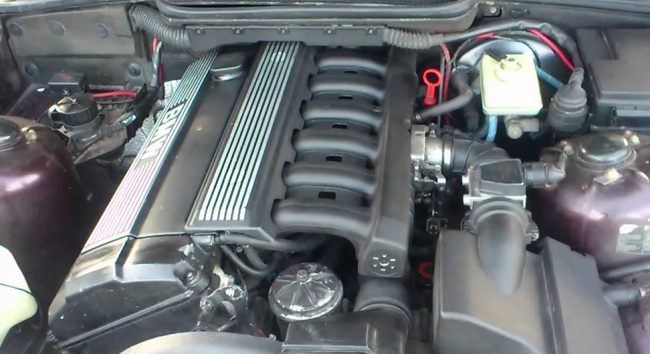
Engines BMW M50B20, M50B20TU
Content
BMW M50B20, M50B20TU are reliable and long-lived engines of the German concern, which have a huge resource. They came to replace the outdated motors of the M20 family, which no longer meet modern requirements, including environmental friendliness. And although the M50 units were successful, they were produced for only 6 years - from 1991 to 1996. Later they created engines with aluminum cylinder blocks - with the M52 index. They were technically better, but had a much smaller resource. So the M50s are older engines, but also more reliable.

Parameters
Characteristics of BMW M50B20 and M50B20TU engines in the table.
| Manufacturer | Munich plant |
|---|---|
| Exact volume | 1.91 l |
| Cylinder block | Cast iron |
| Food | Injector |
| A type | Inline |
| Number of cylinders | 6 |
| Number of valves | 4 per cylinder, 24 total |
| Piston stroke | 66 mm |
| Compression ratio | 10.5 in basic version, 11 in TU |
| Power | 150 h.p. at 6000 rpm |
| 150 HP at 5900 rpm - in the TU version | |
| Torque | 190 Nm at 4900 rpm |
| 190 Nm at 4200 rpm - in TU version | |
| Fuel | Gasoline AI-95 |
| Environmental Compliance | Euro-1 |
| Gasoline consumption | In the city - 10-11 liters per 100 km |
| On the highway - 6.5-7 liters | |
| Engine oil volume | 5.75 l |
| Required viscosity | 5W-30, 5W-40, 10W-40, 15W-40 |
| Possible oil consumption | Up to 1 l/1000 km |
| Relubrication through | 7-10 thousand km. |
| Engine resource | 400+ thousand km. |
Given that the engine was produced for only 5-6 years, it was installed on only a few BMW models:
BMW 320i E36 is the best-selling sedan with a 2-liter engine. Almost 197 thousand units of such cars were produced, which
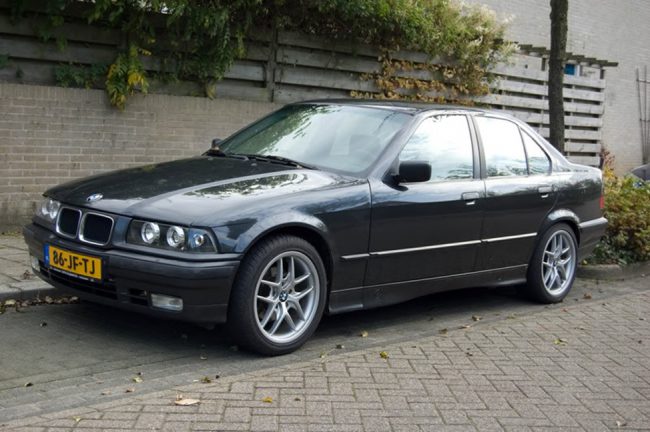
speaks of the extremely high demand and reliability of not only the car itself, but also the engine.
BMW 520i E34 is almost a legend of the German car industry, which was produced from 1991 to 1996. In total, almost 397 thousand copies were produced. And although the car has a bad past in Russia (because of the people who drove it), it remains a legend. Now on the roads of Russia it is easy to meet these cars, however, little remains of their original appearance - they are mainly tuned.
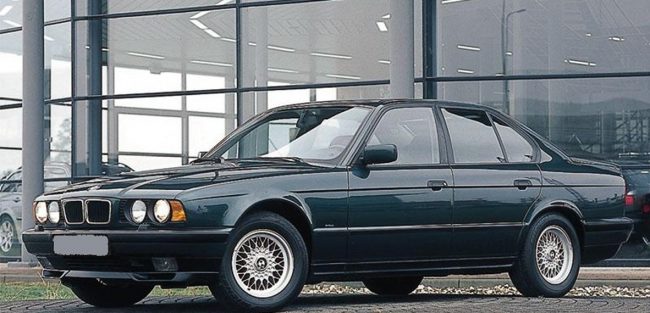
Description of BMW M50B20 and M50B20TU engines
The M50 series includes engines with a cylinder capacity of 2, 2.5, 3 and 3.2 liters. The most popular were the M50B20 engines with an exact volume of 1.91 liters. The engine was created as a replacement for the outdated M20B20 engine. Its main improvement over its predecessors is a block with 6 cylinders, each of which has 4 valves. The cylinder head also received two camshafts and hydraulic lifters, thanks to which the need to adjust valve clearances after 10-20 thousand km was eliminated.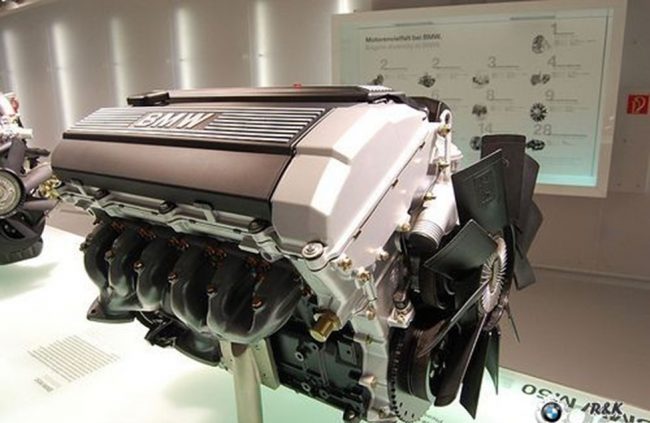
The BMW M50B20 and M50B20TU use camshafts with a phase of 240/228, inlet valves with a diameter of 33 mm, exhaust valves - 27 mm. It also features a plastic intake manifold to reduce the overall weight of the engine, and its design has been improved compared to the predecessors of the M20 family.
Also in the M50B20, instead of a belt drive, a reliable chain drive is used, the service life of which is 250 thousand kilometers. This means that owners can forget about the problem of a broken belt and subsequent bending of the valves. Also in the internal combustion engine, an electronic ignition system was used, instead of a distributor, ignition coils, new pistons, and light connecting rods were installed.
In 1992, the M50B20 engine was modified with a special Vanos system. It was named M50B20TU. This system provides dynamic control of the camshafts, that is, a change in the valve timing. Thanks to this technology, the curve of torque parameters becomes even, the engine thrust also becomes stable in all ranges of its operation. That is, on the M50B20TU engine at low and high speeds, the torque will be higher than on the M50B20, which will ensure the dynamics (acceleration) of the car and, in theory, save fuel. Regardless of the speed of rotation of the crankshaft, the engine becomes more economical and environmentally friendly, and most importantly - more powerful.
There are several VANOS systems: Mono and Double. The M50B20 uses the usual mono-VANOS intake system, which changes the opening phases of the intake valves. In fact, this technology is an analogue of the well-known VTEC and i-VTEC from HONDA (each manufacturer has its own name for this technology).
Purely technically, the use of VANOS on the M50B20TU made it possible to shift the maximum torque towards lower speeds - up to 4200 rpm (4900 rpm in the M50B20 without the VANOS system).
So, the 2-liter engine of the M50 family received 2 modifications:
- Basic variation without Vanos system with a compression ratio of 10.5, 150 hp. and a torque of 190 Nm at 4700 rpm.
- With Vanos system, new camshafts. Here, the compression ratio was raised to 11, the power is the same - 150 hp. at 4900 rpm; torque - 190 Nm at 4200 rpm.
If you choose between two options, then the second is preferable. Due to the stabilization of torque at low, medium and high speeds, the engine runs more economically and more stable, and the car becomes more dynamic and responsive to the gas pedal.
Tuning
Engines with a cylinder capacity of 2 liters do not have high power a priori, so the owners of the M50B20 often try to improve them. There are ways to add horsepower without losing a resource.
An easy option is to buy an M50B25 motor for Swap. It is fully suitable as an effective replacement on vehicles with M50B20 and 2 hp more powerful than the 42-litre version. Plus, there are ways to modify the M50B25 to further boost the power.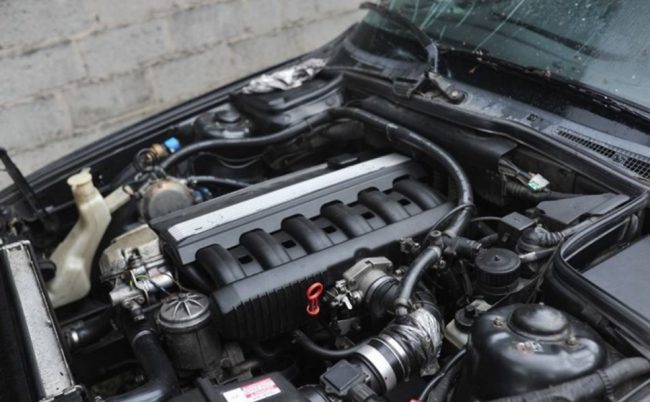
There are also options for modifying the "native" M50B20 engine. The easiest is to increase its volume from 2 to 2.6 liters. To do this, you need to buy pistons from M50TUB20, air flow sensors and crankshaft - from M52B28; connecting rods remain "native". You will also need to take a few components from the B50B25: throttle valve, tuned ECU, pressure regulator. If all this is correctly installed on the M50B20, then its power will increase to 200 hp, the compression ratio will rise to 12. Accordingly, fuel with a higher octane rating will be required, so only AI-98 gasoline will have to be refueled, otherwise detonation will occur and power drop. By installing a thick gasket on the cylinder head, you can also drive on AI-95 gasoline without problems.
If the engine is with the Vanos system, then the nozzles must be selected from M50B25, the connecting rods from M52B28.
The changes made will raise the capacity of the cylinders - the result will be an almost full-fledged M50B28, but to unlock its full potential, it is necessary to install a throttle valve and intake manifold from the M50B25, a sports equal-length manifold, expand and modify the inlet and outlet channels of the cylinder head (porting). These changes will increase power to the maximum possible - such a motor will significantly exceed the power of the M50B25.
On sale on the relevant resources there are stroker kits that allow you to get a cylinder volume of 3 liters. To do this, they need to be bored to 84 mm, pistons with rings, crankshaft and connecting rods from m54B30 should be installed. The cylinder block itself is ground off by 1 mm. The cylinder head and liners are taken from the M50B25, 250 cc injectors are installed, a complete set of timing chains. There will be few components left from the main M50B20, now it will be the M50B30 Stroker with a volume of 3 liters.
You can achieve maximum power without using a supercharger by installing Schrick 264/256 camshafts, nozzles from S50B32, 6-throttle intake. This will allow you to remove about 260-270 hp from the engine.
Turbo kit
The easiest way to turbocharge a 2L M50 is to fit a Garrett GT30 turbo kit with MAP sensors, turbo manifold, broadband lambda probes, high performance 440cc injectors, full intake and exhaust. You will also need special firmware for all these components to work properly. At the output, the power will increase to 300 hp, and this is on the stock piston group.
You can also install 550 cc injectors and a Garett GT35 turbo, replace the factory pistons with CP Pistons, install new APR connecting rods and bolts. This will remove 400+ hp.
Problems
And although the M50B20 engine has a long resource, it has some problems:
- Overheat. It is characteristic of almost all internal combustion engines with the M index. The unit is hard to tolerate, so exceeding the operating temperature (90 degrees) should cause driver concern. You need to check the thermostat, pump, antifreeze. Perhaps overheating is caused by the presence of air pockets in the cooling system.
- Trouble caused by broken nozzles, ignition coils, spark plugs.
- Vanos system. Often, owners of engines with this technology complain about rattling in the cylinder head, swimming speed, and a decrease in power. You will have to buy a Vanos M50 repair kit.
- Swimming revolutions. Everything is standard here: a broken idle valve or throttle position sensor. Most often solved by cleaning the motor and the damper itself.
- Oil waste. Due to the natural wear and tear of the M50B20 engine, they can “eat” 1 liter per 1000 km. An overhaul may temporarily or not solve the problem at all, so you just have to add oil. Also, the valve cover gasket may leak here, even oil can escape through the dipstick.
- The expansion tank on antifreeze can crack over time - the coolant will leave through the crack.
These problems occur on used motors, but this is completely normal. Despite everything, the M50 engines are exceptionally reliable. These are generally legendary motors, which of all the internal combustion engines created by the German concern are among the best and most successful. They are devoid of design miscalculations, and the problems that arise are more related to wear or improper operation.
With proper and timely maintenance, the use of high-quality and original "consumables", the motor resource exceeds 300-400 thousand kilometers. He has a reputation of a millionaire, but to pass 1 million km. possible only with perfect service.
Contract engines
And although the last ICEs rolled off the assembly line in 1994, today they are still on the move, and it is easy to find contract engines at the appropriate sites. Their price depends on the mileage, condition, attachments, year of manufacture.
Prices are different - from 25 to 70 thousand rubles; the average price is 50000 rubles. Here are screenshots from the relevant resources.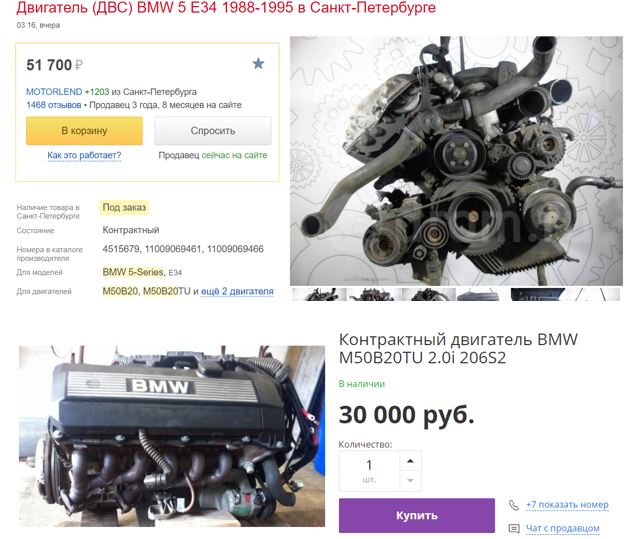

For little money, the engine can be purchased and put on your car, if necessary.
Conclusion
Cars based on the BMW M50B20 and M50B20TU internal combustion engines are not recommended for purchase for a simple reason - their resource has been rolled out. If you choose a BMW based on them, then be prepared to invest in repairs. However, given the huge resource of the motor, models with a range of 200 thousand km may be able to drive the same amount, but this does not eliminate the need for minor or medium repairs.

